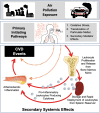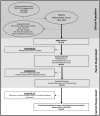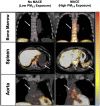A leucopoietic-arterial axis underlying the link between ambient air pollution and cardiovascular disease in humans
- PMID: 33428721
- PMCID: PMC7882372
- DOI: 10.1093/eurheartj/ehaa982
A leucopoietic-arterial axis underlying the link between ambient air pollution and cardiovascular disease in humans
Abstract
Aims: Air pollution [i.e. particulate matter with diameter <2.5 μm (PM2.5)] is a risk factor for major adverse cardiovascular events (MACE). While PM2.5 promotes leucopoiesis and atherosclerotic inflammation in experimental models, it is unknown whether this occurs in humans. We tested in humans (a) whether PM2.5 associates with higher leucopoietic tissue activity and arterial inflammation (ArtI), (ii) whether these associations persist after accounting for the effects of potential confounders including socioeconomics, traffic noise, and risk factors, and (iii) whether these tissue effects mediate the association between air pollution and MACE.
Methods and results: Individuals (N = 503) without cardiovascular disease (CVD) or active malignancy underwent 18 F-fluorodeoxyglucose positron emission tomography/computed tomography. Major adverse cardiovascular event was adjudicated over 5 years of follow-up. Leucopoietic tissue activity (in bone marrow and spleen) as well as ArtI were measured. Annual PM2.5 levels were assessed at each individual's home address. At baseline, higher PM2.5 associated with increased leucopoietic activity [standardized (95% CI): 0.129 (0.042, 0.215), P = 0.004] as well as ArtI [0.088 (0.006, 0.171), P = 0.036] after adjusting for CVD risk factors. Over a median 4.1 years, 40 individuals experienced MACE. PM2.5 exposure associated with MACE [Cox HR (95% CI): 1.404 (1.135, 1.737), P = 0.002], remaining significant after adjustment for CVD risk factors and other potential confounders. Mediation analysis demonstrated that increased leucopoietic activity and ArtI serially mediate the link between PM2.5 exposure and MACE.
Conclusions: Higher air pollution exposure associates with heightened leucopoietic activity and ArtI and independently predicts MACE through a biological pathway that includes higher leucopoietic activity and ArtI in series.
Keywords: 18F-FDG-PET/CT; Air pollution; Arterial inflammation; Cardiovascular disease; Leucopoietic activity.
Published on behalf of the European Society of Cardiology. All rights reserved. © The Author(s) 2021. For permissions, please email: journals.permissions@oup.com.
Figures






References
-
- Rajagopalan S, Al-Kindi SG, Brook RD. Air pollution and cardiovascular disease: JACC state-of-the-art review. J Am Coll Cardiol 2018;72:2054–2070. - PubMed
-
- Miller KA, Siscovick DS, Sheppard L, Shepherd K, Sullivan JH, Anderson GL, Kaufman JD. Long-term exposure to air pollution and incidence of cardiovascular events in women. N Engl J Med 2007;356:447–458. - PubMed
-
- Newby DE, Mannucci PM, Tell GS, Baccarelli AA, Brook RD, Donaldson K, Forastiere F, Franchini M, Franco OH, Graham I, Hoek G, Hoffmann B, Hoylaerts MF, Kunzli N, Mills N, Pekkanen J, Peters A, Piepoli MF, Rajagopalan S, Storey RF. Expert position paper on air pollution and cardiovascular disease. Eur Heart J 2015;36:83–93b. - PMC - PubMed
Publication types
MeSH terms
Substances
Grants and funding
LinkOut - more resources
Full Text Sources
Other Literature Sources
Medical

